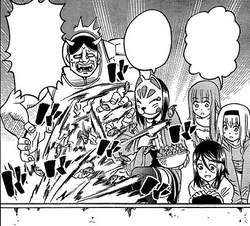
Travelling mask vendors follow the Japanese festival circuit all over the country selling plastic masks in the shape of popular cartoon characters and mythical creatures. These masks can be found at virtually every Japanese festival.
Mask Types[]
Hyottoko Mask[]

Hyottoko (火男) is a comical Japanese character who is prominently portrayed through a mask of a man with a puckered mouth that is skewed to one side. He is also often wearing a scarf around his head (usually white with blue dots).
The origins of Hyottoko differ widely by region. In one example, he was a boy who could produce gold from his bellybutton. In another example he is a god of fire and the face is skewed the way it is because the character is blowing fire through a bamboo pipe, hence the shape of the mouth.
Considered a lucky spirit, Hyottoko plays a role in a number of traditional dances as a clown-like figure with foolish steps.
Tengu Mask[]

Tengu are a mythical Japanese creature that were historically thought to be troublesome demons but are now respected as protectors of sacred forests and mountains. Tengu were originally represented as bird-like creatures but with time evolved to look somewhat humanoid with a giant nose.
Tengu masks are worn at a variety of festivals and are a popular ornament to decorate temples and businesses such as restaurants.
Kitsune Mask[]

Kitsune is the Japanese word for fox. According to Japanese traditions, foxes are thought to be the messengers of the goddess Inari. In Japanese myth, the gods themselves may appear as foxes. In other stories, foxes may appear as beautiful women to trick humans.
Fox masks play a role in various festivals that celebrate these old myths.
Okame Mask[]

Okame (阿亀) (also known as Otafuku (阿多福)) is essentially the female version of Hyottoko.
Often seen together as a pair, Okame is a lucky spirit who is considered a symbol for long life. The spirit represents a lovely, always smiling, Japanese woman who brings happiness and good fortune to any man she marries. She is often associated with Ame no Uzume; the Goddess of Mirth.
Oni Mask[]

Oni are a generic Japanese demon or ogre. They are mischievous creatures who aren't particularly difficult to scare away with a little effort. Oni masks range from comical to incredibly fearsome. Rural Japanese festivals often involve locals wearing oni masks running wild with mischief through the streets.
On the Setsubun holiday, parents all over Japan put on Oni masks to scare the kids. The kids in turn scare the Oni away by throwing beans.
Gallery[]
Trivia[]
- The masks only fit the smallest of children so adults typically wear them to the side or back of their head, as seen for example with Kimihito in Chapter 42.

